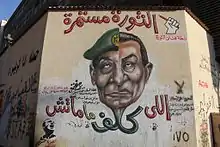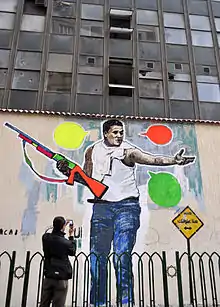Mohamed Mahmoud graffiti
Mohamed Mahmoud Graffiti is a collection of graffiti that was painted on several walls in the area surrounding Mohamed Mahmoud street near Tahrir Square in Cairo, Egypt during the 2011 Egyptian revolution.

Following the outbreak of the Egyptian Revolution of 2011, several protests took place in Egypt later that year, all centered on Tahrir Square. During 19 to 24 November 2011,[1] protests took place surrounding Mohamed Mahmoud street in reaction to the Egyptian police and Central Security Forces's brutal attack on peaceful protesters near the area on November 19.
Areas bearing the graffiti included the walls of The American University in Cairo and some buildings and schools surrounding it, and the concrete wall that was installed later in Mohamed Mahmoud street to stop protesters from advancing to the Ministry of Interior building.
The rise of art activism in Egypt
Art activism have had a major influence on the unfolding of the huge political movements that have taken place in Egypt over these years.[2] No art form has represented the enthusiasm and overwhelm of feelings that occurred as a result of Egypt's 2011 revolution as vividly as graffiti. In the beauty of their drawings and bright colours, Some of the graffiti's illustrate a resemblance to the Pharaohs’ graffiti of the past, a major pillar of Egyptian culture and society.[3] Influenced by the rise of graffiti around the globe, Egyptian artists began attempting different styles and sketches, mixing Egyptian-influenced style with famous icons and Arabic calligraphy, as a form of revolt. This artistic rise, both purging and expressing, allowed artists to thrive and create art influenced by the political and social condition of Egypt. Still, danger presents itself, as artists continue to work under oppressive regimes.[4]
Types of graffiti
Early in the revolution, graffiti commonly consisted of slogans of the Egyptian revolution; images of prominent revolutionary figures, including Sambo, Mina Daniel, Ahmed Harara and Sheikh Imad Effat; and the likenesses of authority figures like Field Marshal Tantawi and Lieutenant Mahmoud Shinawi.[5]

"The No Wall" initiative was launched in mid-March 2011. The initiative called on artists to paint graffiti on concrete blocks that authorities installed in the main streets leading to the Interior Ministry and the headquarters of the Egyptian Parliament. Blocks were painted with the "No Wall" slogan and scenes of security forces attacking protesters.[6]
Later on, images of martyrs of the revolution were added, including some the faces of members of the Ultras Ahlawy, which formed the majority of the victims of the Port Said Stadium massacre. Graffiti also included slogans demanding the handover of power to civilians and end of the military rule. Some graffiti represented clashes with Copts in front of the TV building in Maspero in October 2011, the so-called Maspero Massacre.
Graffiti painted on the wall of the American University depicting the rise of revolution martyrs to paradise was inspired by the painting styles of the ancient Egyptians recorded on the walls of Pharaonic funerary temples.[7] The pharaonic past is a theme frequently represented in contemporary Egyptian graffiti, perhaps as a self-justification for artists seeing that in the times of the Pharaohs local traditions of mural paintings existed and thus this modern form of mural art gets validated by a glorious past.[8]
Artists included
The drawings on the murals featured then-upcoming artists and activists. "Amr Picasso", one of the graphic artists who participated in the protests of "Mohammed Mahmoud" and witnessed the events that occurred, drew some of the graffiti. One of the most famous works, the General Tantawi and former president Mubarak, was drawn by Egyptian artist Mohamed Fathi.[9]
Removal of graffiti
The provincial department of Cairo has removed the murals several times, as it did on May 21 and September 18, 2012. It is also reported that the Central Security Forces and the management of the American University participated in such efforts.[10] An initiative was made earlier by the American University to preserve the murals.[11] Some of this graffiti remain documented and even published by admirers who collected photographs taken by visitors[12] during the given time.[13][14] Freedom of expression has always been a challenging issue. President Gamal Abdel Nasser nationalized the press in the 1950s and it has been the case since. Thus, to write or draw in the hope of mobilize opposition has always been under scrutiny, in the fear of revolt.[15]
Preservation of the graffiti
Some photographers successfully attempted to photograph the graffiti that occupied the murals since the outbreak of the January revolution in Egypt and, thus, some of them have been documented and archived in published works and research material such as the documentary book "Land, Land: The Story of the Graffiti Revolution" by writer and photographer Sherif Abdel Majid [16]
See also
References
- Egypt Independent, Mohamed Mahmoud clashes enter fourth day, November 22, 2011
- https://www.ft.com/content/6be35daa-79a1-11e6-97ae-647294649b28
- http://portraitsofegypt.com/en/english-pharaohs-legacy-in-the-revolution-graffiti-cairo/
- https://genprogress.org/egyptian-artists-work-through-state-oppression-and-censorship/
- "Trial of Mohamed Mahmoud 'eye sniper' adjourned to July". Egypt Independent. Retrieved 2012-09-19.
- "ميدل ايست أونلاين:.فنانون مصريون يرسمون الثورة على الجدران:". Middle-east-online.com. 2012-03-25. Retrieved 2012-09-19.
- Abaza, Mona. "An Emerging Memorial Space? In Praise of Mohammed Mahmud Street". Jadaliyya.com. Retrieved 2012-09-19.
- Nicoarea, Georgiana. "Cairo's New Colors: Rethinking Identity in the Graffiti of the Egyptian Revolution". Romano-Arabica Journal. Retrieved 2014-05-10.
- https://www.masrawy.com/news/news_various/details/2014/11/19/391968/%D8%A7%D9%84%D8%AC%D8%B1%D8%A7%D9%81%D9%8A%D8%AA%D9%8A-%D8%AD%D9%83%D8%A7%D9%8A%D8%A9-%D9%85%D8%AD%D9%85%D8%AF-%D9%85%D8%AD%D9%85%D9%88%D8%AF-%D8%B9%D9%84%D9%89-%D8%A7%D9%84%D8%AC%D8%AF%D8%B1%D8%A7%D9%86
- "طمس جدارية محمد محمود لثالث مرة وضياع مجهود فناني الثورة". Noreed.com. Retrieved 2012-09-19.
- "Preserving Mohamed Mahmoud Murals; See Photo Gallery". Aucegypt.edu. Archived from the original on 2015-03-24. Retrieved 2012-09-19.
- أحمد خلىل هىثم سلامة اسماعىل مصطفى. "مصرس : جداريات محمد محمود تجذب المترددين علي الميدان لالتقاط الصور". Masress.com. Retrieved 2012-09-19.
- "دار الخليــــج-الخليج الثقافي-الجرافيتي "فن الغضب والشوارع"". Alkhaleej.ae. Retrieved 2012-09-19.
- اليوم السابع – السبت، 25 فبراير 2012 (2011-04-20). "عبد المجيد يوقع "أرض أرض.. حكاية ثورة الجرافيتى".. بـ"شبابيك" - أخبار Yahoo! مكتوب". Maktoob.news.yahoo.com. Retrieved 2012-09-19.CS1 maint: multiple names: authors list (link)
- https://www.nytimes.com/2018/12/08/opinion/sunday/egypt-censorship-crowdsourcing.html
- https://www.masrawy.com/news/news_various/details/2014/11/19/391968/%D8%A7%D9%84%D8%AC%D8%B1%D8%A7%D9%81%D9%8A%D8%AA%D9%8A-%D8%AD%D9%83%D8%A7%D9%8A%D8%A9-%D9%85%D8%AD%D9%85%D8%AF-%D9%85%D8%AD%D9%85%D9%88%D8%AF-%D8%B9%D9%84%D9%89-%D8%A7%D9%84%D8%AC%D8%AF%D8%B1%D8%A7%D9%86.